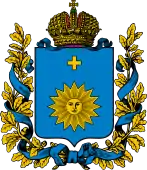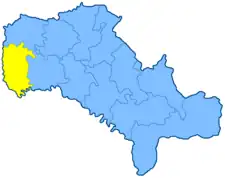Kamenets-Podolsky uezd
The Kamenets-Podolsky uezd[lower-alpha 1] was a county (uezd) of the Podolian Governorate of the Russian Empire. The uezd bordered the Proskurov uezd to the north, the Ushitsa uezd to the east, the Khotin uezd to the south, and Austria to the west. Its administrative centre of the county was Kamenets-Podolsky (modern-day Kamianets-Podilskyi). The county covered most of the area of Kamianets-Podilskyi Raion.
Kamenets-Podolsky uezd
Каменецъ-Подольскій уѣздъ | |
|---|---|
 Coat of arms | |
 Location in the Podolia Governorate | |
| Country | Russian Empire |
| Krai | Southwestern |
| Governorate | Podolia |
| Established | 1795 |
| Abolished | 1923 |
| Capital | Kamenets-Podolsky |
| Area | |
| • Total | 2,884.19 km2 (1,113.59 sq mi) |
| Population (1897) | |
| • Total | 266,350 |
| • Density | 92/km2 (240/sq mi) |
| • Urban | 13.49% |
| • Rural | 86.51% |
Administrative divisions
The subcounties (volosts) of the Kamenets-Podolsky uezd in 1912 were as follows:[1]
| Name | Name in Russian | Capital |
|---|---|---|
| Bogovitsa volost | Баговицкая волость | Bogovitsa |
| Balin volost | Балинская волость | Balin |
| Berezhanka volost | Бережанская волость | Berezhanka |
| Gavrilovtse volost | Гавриловецкая волость | Gavrilovtse |
| Gorodok volost | Городокская волость | Gorodok |
| Dolzhok volost | Должецкая волость | Dolzhok |
| Kupin volost | Купинская волость | Kupin |
| Kuyavy volost | Куявская волость | Kuyavy |
| Lyantskorun volost | Лянцкорунская волость | Lyantskorun |
| Makov volost | Маковская волость | Makov |
| Olkhovets volost | Ольховецкая волость | Olkhovets |
| Orynin volost | Орынинская волость | Orynin |
| Rykhta volost | Рыхтецкая волость | Rykhta |
| Smotrich volost | Смотричская волость | Smotrich |
| Tsykova volost | Цыковская волость | Tsykova |
Demographics
At the time of the Russian Empire Census on 28 January [O.S. 15 January] 1897, the Kamenets-Podolsky uezd had a population of 266,350, including 132,750 men and 133,600 women. The majority of the population indicated Little Russian[lower-alpha 2] to be their mother tongue, with significant Jewish and Great Russian speaking minorities.[4]
| Language | Native speakers | Percentage |
|---|---|---|
| Little Russian[lower-alpha 2] | 210,264 | 92.89 |
| Jewish | 37,114 | 16.40 |
| Great Russian[lower-alpha 2] | 10,922 | 4.83 |
| Polish | 7,275 | 3.21 |
| German | 230 | 0.10 |
| Tatar | 218 | 0.10 |
| White Russian[lower-alpha 2] | 94 | 0.04 |
| Votyak | 76 | 0.03 |
| French | 32 | 0.01 |
| Czech | 30 | 0.01 |
| Romanian | 10 | 0.00 |
| Bashkir | 9 | 0.00 |
| Cheremis | 9 | 0.00 |
| Mordovian | 5 | 0.00 |
| Chuvash | 2 | 0.00 |
| Gipsy | 1 | 0.00 |
| Latvian | 1 | 0.00 |
| Other | 58 | 0.03 |
| Total | 226,350 | 100.00 |
Notes
- Prior to 1918, the Imperial Russian government classified Russians as the Great Russians, Ukrainians as the Little Russians, and Belarusians as the White Russians. After the creation of the Ukrainian People's Republic in 1918, the Little Russians identified themselves as "Ukrainian".[2] Also, the Belarusian Democratic Republic which the White Russians identified themselves as "Belarusian".[3]
References
- Волостныя, станичныя, сельския, гминныя правления и управления, а также полицейские станы всей России с обозначением места их нахождения [Volostny, stanichnaya, rural, communes of government and administration, as well as police camps throughout Russia with the designation of their location]. Kiev: Izd-vo T-va L. M. Fish. 1913. p. 162. Archived from the original on 2022-12-11.
- Hamm, Michael F. (2014). Kiev: A Portrait, 1800–1917. Princeton University Press. p. 83. ISBN 978-1-4008-5151-5.
- Fortson IV, Benjamin W. (2011). Indo-European Language and Culture: An Introduction. John Wiley & Sons. p. 429. ISBN 978-1-4443-5968-8.
- "Демоскоп Weekly - Приложение. Справочник статистических показателей". www.demoscope.ru. Retrieved 2019-12-19.